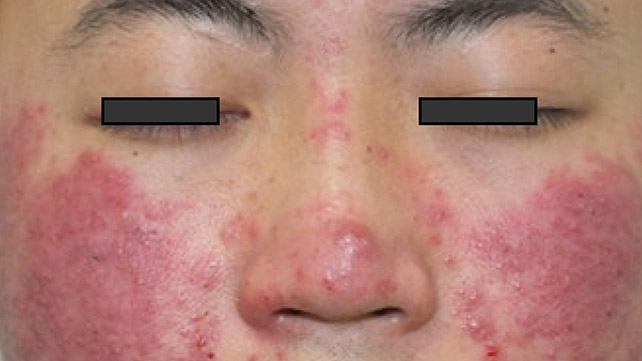Demodex Treatment Face
Demodex Treatment Face: Banishing the Unwanted Guests
Introduction
In the realm of skincare woes, one tiny, tenacious mite has recently taken center stage – Demodex. These microscopic arachnids have long cohabited with humans, dwelling harmlessly on our faces. However, when their population spirals out of control, they can lead to a range of skin issues. In this comprehensive guide, we will explore everything you need to know about Demodex, from understanding the symptoms to discovering effective treatments.
Unveiling Demodex
What are Demodex Mites?
Demodex mites are tiny parasites that reside in the hair follicles and sebaceous glands of the human face. They are a natural part of our skin's ecosystem and typically coexist without causing any harm. However, when their numbers multiply excessively, it can lead to various skin problems.
Demodex mites are microscopic parasites that naturally inhabit the hair follicles and sebaceous (oil) glands of the human face. These mites are a part of the human skin's ecosystem and are, in most cases, harmless when they exist in small numbers.
Here's a more detailed breakdown:
- Microscopic Size: Demodex mites are incredibly tiny, measuring only about 0.1 to 0.4 millimeters in length. They are almost impossible to see with the naked eye.
- Hair Follicle Dwellers: They prefer to live inside hair follicles, which are tiny pockets in the skin from which hair grows. These follicles are found all over our face.
- Sebaceous Gland Residents: Demodex mites are also found in the sebaceous glands. These glands produce sebum, an oily substance that helps lubricate the skin and hair. Demodex mites feed on sebum and the dead skin cells that accumulate in these glands.
- Normal Skin Inhabitants: Importantly, Demodex mites are not invaders; they are a natural part of our skin's environment. In fact, most people have some Demodex mites on their skin without even being aware of it.
- Nighttime Activity: These mites are most active during the night when they come to the skin's surface to mate and lay eggs. This activity is usually harmless and goes unnoticed.
However, problems can arise when the Demodex mite population multiplies excessively. When their numbers get out of control, they can lead to various skin issues, including persistent itching, redness, inflammation, and even acne-like bumps.
Demodex mites are tiny, usually harmless creatures that naturally live on our skin. However, when their numbers grow too large, they can contribute to skin problems, making it important to maintain a healthy balance of these mites on your face.
.jpg)
The Role of Demodex in Skin Health
Demodex mites feed on sebum, dead skin cells, and other microscopic debris. In moderation, this interaction can actually benefit the skin by aiding in the removal of impurities. However, an overabundance of Demodex can lead to inflammation, redness, and itching.
Demodex mites, despite their minuscule size and often misunderstood reputation, play a significant role in maintaining skin health when their populations are in balance. Here's how they contribute to our skin's well-being:
- Sebum Regulation: Demodex mites feed on sebum, the natural oil produced by our sebaceous glands. In moderation, this is beneficial as it helps regulate sebum levels on the skin. Sebum is essential for skin health because it moisturizes and protects the skin, preventing it from drying out.
- Exfoliation: These mites also consume dead skin cells. This consumption serves as a form of natural exfoliation. By removing dead skin cells, Demodex mites help keep the skin's surface smooth and free from debris.
- Microbial Balance: Demodex mites may also help in maintaining a balanced microbial environment on the skin. By feeding on certain microbes, they prevent an overgrowth of harmful bacteria that could lead to skin infections or other skin issues.
- Follicular Health: These mites inhabit hair follicles, and their presence can help keep these follicles clean and clear. This is crucial because clogged hair follicles can lead to conditions like acne or folliculitis.
- However, problems can arise when the Demodex mite population becomes excessive. An overabundance of these mites can lead to the following issues:
- Inflammation: When Demodex mites multiply in large numbers, they can irritate the skin and cause redness and inflammation.
- Itching: An overpopulation of Demodex mites can lead to persistent itching, which can be quite uncomfortable.
- Skin Problems: The presence of too many Demodex mites can contribute to the development of skin conditions such as rosacea or Demodex folliculitis.
Demodex mites have a role in maintaining skin health when their numbers are balanced. They contribute to sebum regulation, natural exfoliation, and microbial balance. However, when their population grows excessively, it can lead to skin problems. Achieving a healthy balance of Demodex mites on the skin is key to maintaining overall skin health.
Identifying Demodex Infestation
Symptoms of Demodex Infestation
- Persistent Itching: An unrelenting itch, especially around the nose, eyebrows, and cheeks.
- Redness and Inflammation: Skin appears flushed and irritated.
- Acne-Like Bumps: Pimple-like bumps that are often confused with acne.
- Rough and Dry Skin: Skin texture becomes coarse and uneven.
- Increased Sensitivity: Skin becomes more sensitive to various skincare products.
- Persistent Itching: One of the hallmark symptoms of Demodex infestation is relentless itching. This itching is often most pronounced around the nose, eyebrows, and cheeks. It can be mild to severe and is typically worse at night when the mites are most active.
- Redness and Inflammation: The presence of an excessive number of Demodex mites can lead to skin redness and inflammation. The affected areas may appear flushed or have a blotchy, irritated appearance.
- Acne-Like Bumps: Demodex infestation can cause the development of small, pimple-like bumps on the skin. These bumps are often mistaken for acne but may not respond well to traditional acne treatments.
- Rough and Dry Skin: As Demodex mites disrupt the skin's natural balance, it can lead to changes in skin texture. The skin may become rough and feel dry, even in areas that are typically oily.
- Increased Sensitivity: The skin may become more sensitive to various skincare products, leading to stinging or burning sensations upon application.
- Eyelash and Eyelid Issues: In some cases, Demodex mites can infest the eyelashes and eyelids, leading to symptoms such as itching, redness, and a gritty sensation in the eyes. This condition is known as Demodex blepharitis.
Demodex Treatment Options
1. Gentle Cleansing
One of the first steps in demodex treatment is maintaining proper facial hygiene. Use a mild, non-comedogenic cleanser to remove dirt and excess oil. Avoid harsh scrubbing, as it can aggravate the condition.
2. Tea Tree Oil
Tea tree oil possesses natural anti-parasitic properties. Dilute a few drops of tea tree oil in a carrier oil, such as coconut oil, and apply it to affected areas. Be cautious not to use it in excessive amounts, as it can be drying.
3. Prescription Medications
In severe cases, a dermatologist may prescribe medicated creams or ointments. These can contain ingredients like metronidazole or permethrin, which help in controlling Demodex populations.
4. Lifestyle Changes
Maintaining a healthy lifestyle can also aid in controlling Demodex infestations. This includes managing stress, getting adequate sleep, and avoiding excessive alcohol consumption.
Preventing Demodex Reoccurrence
1. Wash Bedding Regularly
Demodex mites can transfer from your face to your pillowcases and sheets. Regularly washing and changing bedding can help prevent reinfestation.
2. Avoid Sharing Personal Items
Avoid sharing towels, pillowcases, or makeup with others, as Demodex mites can spread through close contact.
3. Stay Informed
Keep yourself informed about the latest skincare practices and products that can help in managing Demodex.
Conclusion
Demodex infestations can be bothersome, but with the right approach, they can be effectively managed. By maintaining good hygiene, exploring natural remedies, and seeking professional guidance when necessary, you can bid farewell to these unwanted guests and restore your skin's health.
FAQs (Frequently Asked Questions)
1. Are Demodex mites harmful?
Demodex mites are typically harmless in small numbers. However, when their population grows excessively, they can lead to skin problems.
2. Can I use over-the-counter treatments for Demodex?
Mild Demodex infestations may respond to over-the-counter remedies, but for severe cases, it's best to consult a dermatologist.
3. How can I prevent Demodex reoccurrence?
Regularly washing bedding, avoiding shared personal items, and practicing good facial hygiene can help prevent Demodex reoccurrence.
4. Is tea tree oil safe for Demodex treatment?
Tea tree oil can be effective, but it should be used in moderation and properly diluted to avoid skin irritation.
5. When should I see a dermatologist for Demodex treatment?
If you experience persistent symptoms or suspect a severe Demodex infestation, it's advisable to consult a dermatologist for proper diagnosis and treatment.
Demodex infestation on the face has been implicated in causing rosacea fig1a. Tea tree oil face soap and eyelid scrub for support of demodex blepharitis itchy skin acne dry eyes and rosacea handmade with organic ingredients in south.
 Severe Demodexfolliculorum Associated Oculocutaneous Rosacea In A
Severe Demodexfolliculorum Associated Oculocutaneous Rosacea In A
Demodex treatment face.
They don't normally complete their life cycle in humans but can make for. Learn all about demodex brevis a type of mite that lives in skin follicles. Used daily tea tree oil kills most within a week.
Experience power of tea tree neem lemongrass oils use over the counter effective demodex control products to kill demodex mites on face body and scalp stop skin. Tea tree oil is an effective way to kill demodex mites eyelash mites without skin or eye irritation. Find out what these mites do.
Two species live on humans. Demodex is a genus of tiny mites that live in or near hair follicles of mammals. Authoritative facts about the skin from dermnet New Zealand.
Symptoms include red burning skin with a rough texture. Around 65 species of demodex are known. Diagnosis and treatment overview.
Demodex mites and rosacea seem to be a popular if not somewhat controversial pairingeven though there is no proven link between rosacea symptoms and the presence of. Demodex mites treatment with natural demodex control plus face cream 05 oz. Demodex mites scabies mites which live predominantly on animals can also infect humans.
 Demodex Folliculorum Symptoms Causes And Treatments
Demodex Folliculorum Symptoms Causes And Treatments
 Pictures Of Demodex Mites In Adults And Children Ovante
Pictures Of Demodex Mites In Adults And Children Ovante
Human Demodicosis Daily Regimen And Treatment Facial Cleansers
 Blog Demodex Treatment Human Hair Follicle Mites November 2015
Blog Demodex Treatment Human Hair Follicle Mites November 2015
 The Ecology Of Your Face Demodex Rosacea And You Rosacea Org
The Ecology Of Your Face Demodex Rosacea And You Rosacea Org

